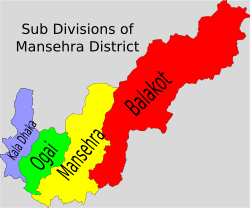Kala Dhaka facts for kids
Kala Dhaka, also known as the Black Mountain of Hazara, is a mountain range. It used to be a special tribal area in Mansehra District, which is part of the Hazara Division. This region is located in the Khyber Pakhtunkhwa province of Pakistan. Since 2011, Kala Dhaka has become its own district within the Hazara Division.
Exploring the Land of Kala Dhaka
Kala Dhaka is located next to the Agror valley, near the Oghi area, on its eastern side. To the south, it borders the region of Tanawal. This mountain range stretches for about 25 to 30 miles from north to south. Its highest points reach about 8,000 feet above sea level.
The mighty Indus River flows through the northern part of the range and then turns south. The western areas, between the river and the mountain peaks, are home to parts of the Yusufzai tribe. The rest of the mountain range is where another local tribe, the Swatis, live.
The Black Mountain has long, narrow ridges with taller peaks appearing now and then. It also has valleys where villages are built for the tribes. The higher parts of the ridges are covered with thick forests. You can find trees like pine, oak, sycamore, horse-chestnut, and wild cherry there. However, the lower slopes are often rocky and bare.
A Look at Kala Dhaka's History
The British government sent armies to the Black Mountain area many times. Between 1852 and 1892, they tried to control the local tribes. This happened because some tribal leaders did not agree with the British rule.
In 1851, two British customs officers were killed in Tanawal. The British believed the Hasanzai group of the Yusufzai tribe was responsible. So, a British army, led by Colonel Mackeson, destroyed several tribal strongholds. Later, in 1868, the Yusufzai tribe, helped by the Khan of Agror, attacked a British police post at Oghi. The Khan of Agror was unhappy because the British had set up this post. The tribes had to retreat from the attack.
The Khan of Tanawal, who later became the Nawab of Amb (princely state), stayed loyal to the British. He faced attacks from tribes who disliked the British. A large group of tribes then marched against the British. The British managed to stop them and push them back. However, during the fighting, twenty-one British villages were burned. After this, the British sent a large army led by General Wilde. His forces took control of the Black Mountain and made the tribes accept British rule.
In 1888, the British blocked off the area. This was because the Hasanzai and Akazai tribes, helped by the Madda Khel tribe, were raiding the Agror valley. While the British were planning stronger actions, Major Battye and Captain Urmston, along with some soldiers, were surprised and killed. This attack was carried out by the ancient Gujar tribe, who were allies of the Akazai.
Hashim Khan, a chief of the Hasanzai and Akazai, was blamed for starting the attack. The British sent armies against the tribes again in 1888. The tribes had to pay a large amount of money to the British. They also had to agree that Hashim Khan was not allowed to live there anymore. The British then made Ibrahim Khan, a relative and enemy of Hashim Khan, the new ruler. Investigations showed that the Khan of Agror had encouraged Hashim and the tribes to rebel. As a result, the Agror Khan was arrested and his lands were taken away in 1889.
In 1890, the tribes stopped British troops from marching along the top of the Black Mountain. So, an army was sent against them in the spring of 1891. As soon as the troops left, some local Hindustani people and the Madda Khel tribe broke their agreement with the British. They allowed Hashim Khan to return. In 1892, the British sent their armies again to fight the tribes. This time, the tribes were finally defeated by the British forces.
The 2005 Earthquake
Kala Dhaka was severely impacted by the 2005 Pakistan earthquake. A report in Time magazine described the damage:
Entire villages were devastated; in an instant, stone houses turned into burial mounds. The Indus river, flowing at the bottom of the valleys, recalls one tribal elder, Mohammed Said, "looked like water boiling inside a tea kettle."


